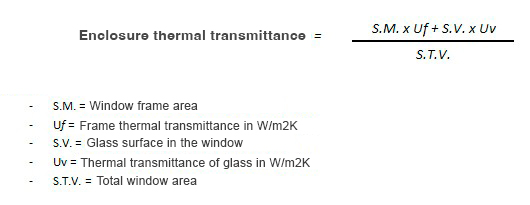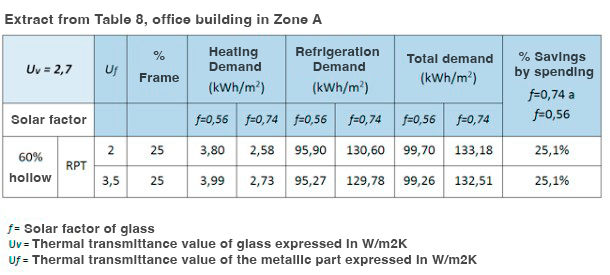
Thermal transmittance
Thermal transmittance measures the heat flow through the material due only to the temperature difference between the outside and the inside, without taking into account solar radiation or air flows through the envelope.
The thermal transmittance of an enclosure is calculated proportionally to the surface occupied by each of the elements of the enclosure.

Analysing current carpentry systems, it is easy to see that the decisive element for the thermal transmittance of the enclosure is the glass, as it is the element that occupies the greatest percentage of the surface area of the window (in many cases it exceeds 80%).
The following table, also taken from the recent TECNALIA study, shows a comparison of the savings obtained by comparing two aluminium frames, both with Thermal Break (RPT). One with a thermal transmittance value of the frames of 2 W/m2K and the other with a thermal transmittance value of 3.5 W/m2K. The table shows that with an improvement in the thermal transmittance of the frames of 43% (from 3.5 to 2 W/m2K), we have an improvement of 0.66% in energy savings. This tells us that the thermal transmittance of the frame is not one of the most decisive factors when assessing the energy efficiency of a building.
In this table, we can see, in the total demand column, the difference in demand for two thermally broken aluminium frames with transmittance values of 2 W/m2K and 3.5 W/m2K respectively.

In effect, we can see the saving of almost 36% (the demand goes from 111 to 71 kWh/m2) that replacing the existing windows, with performance prior to the CTE, with windows with Thermal Bridge Breakage entails. However, the difference between the two series of aluminium windows with RPT, with an improvement in the thermal transmittance of the profiles of 43% (from 3.5 to 2 W/m2K), does not add even an additional 1%.
This leads to the conclusion that the thermal transmittance of the material from which the window profiles are made is not as decisive for energy savings as some would have us believe.







